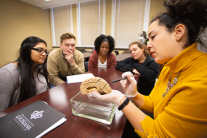Richard "Dan" Hereford (ME '69) and his wife, Larry Ann, have made a transformative $500,000 gift to the University
Student researchers look to unlikely subjects for clues about Alzheimer’s
Mon, 02/10/2020 - 1:57pmBy BAILEY CHENEVERT
University of Louisiana at Lafayette
Student researchers at the University of Louisiana at Lafayette are studying human diseases in surprisingly scaly subjects.
Dr. Erika Caramillo-Hatch, an associate professor of psychology at UL Lafayette, and her student research assistants aim to find answers to some of the mysteries of Alzheimer’s disease by observing the residents of freshwater tanks.
Examining inch-long, freshwater-dwelling zebrafish can provide insight into certain mental disorders and potentially change the way researchers study those disorders.
Caramillo-Hatch said humans share about 70 percent of their ancestral genes with zebrafish, and that’s similar enough to compare their brain functions.
“We’ve all looked into a fish tank and watched them swim and interact with each other, but we might not have known that they were telling us a lot about our own human behavior,” she said.
Scientists have been making similar comparisons between humans and other animals for centuries. Comparative models enable researchers to study human ailments, like cancer and depression, without subjecting humans to their symptoms.
The lab is located at the University’s Ecology Center. There, student researchers reviewed literature produced by researchers at other institutions who’ve studied zebrafish. They found that some have had success replicating conditions like autism and cardiovascular disease.
UL Lafayette researchers want to add Alzheimer’s disease to the list.
Kris Anderson is among four undergraduate and graduate students who work in the lab. The psychology graduate student said working with zebrafish gives her valuable research experience. Students also practice critical thinking and presentation skills in weekly meetings where they review scientific literature.
“My goal eventually is to do neuropsychology and being able to do this neuroscience work with Dr. Caramillo-Hatch will give me a lot of clarity and experience for applications to doctoral programs. Many of these skills are transferable to other labs,” Anderson said.
She added that if the lab is successful, it could help provide mid-sized universities and research institutions with a cost-effective method of studying animal models.
Zebrafish are cheaper and smaller than laboratory mice and have a lifespan of almost two years. The zebrafish’s early development is also easier to study than that of other animals. In addition, they have a hormone called cortisol, a steroid that serves many purposes in the human body, such as regulating metabolism and immune responses, that other animal models don’t produce.
Zebrafish also exhibit behaviors that are comparable to humans. For example, Caramillo-Hatch noted that when zebrafish swim primarily on the sides of a tank and don’t explore the middle, it’s an indicator of anxiety. Much like humans, when zebrafish are stressed or anxious, they are hesitant to leave their comfort zones.
Comparable behaviors like these are integral to Caramillo-Hatch’s research because they help convey the thoughts of organisms that humans can’t communicate with.
“You can’t just ask a zebrafish ‘How are you feeling today?’ They can’t respond like a human would,” she said.
Scientists can induce certain conditions in the zebrafish by changing their environment or diluting drugs in the water they inhabit. By observing their responses, researchers can then better understand how to improve human health and well-being.
Other than mental health and psychology, graduate student Thomas Sease, who is pursuing a master’s degree in psychology, said the zebrafish research could give other inquiring minds with tighter budgets or smaller laboratories the ability to study pathology in animal models.
“Simply establishing the fish as a good comparative model can give more people the opportunity to do important research. This could be really beneficial.”
(Bailey Chenevert is student editor of La Louisiane, the magazine of the University of Louisiana at Lafayette. Chenevert is a senior psychology major who’s minoring in journalism. She will graduate in May.)
Photo caption: Dr. Erika Caramillo-Hatch, an associate professor of psychology at UL Lafayette, shows a human brain to students during a discussion about Alzheimer’s disease. Students from left are Trisha Patel, Thomas Sease, Kris Anderson and Kayla Flora. (Photo credit: Doug Dugas / University of Louisiana at Lafayette)

